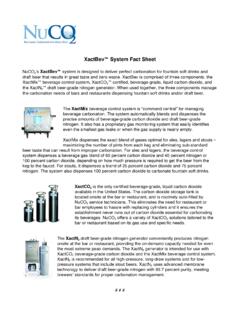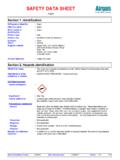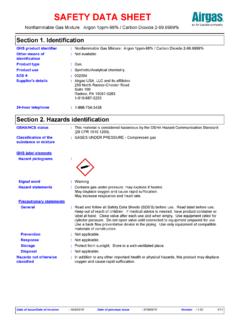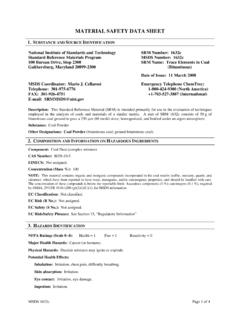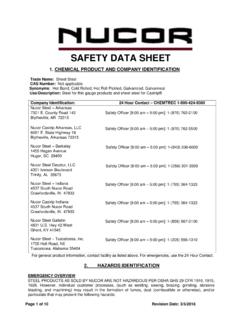Transcription of Praxair Material Safety Data Sheet - NuCO2
1 Product: Extendapak Food Gas Mixtures P-6231-B Date: May 2009 Copyright 2000, 2004, 2009, Praxair Technology, Inc. Page 1 of 9 All rights reserved. A vertical line in the left margin indicates revised or new Material . Praxair Material Safety data Sheet 1. Chemical Product and Company Identification Product Name: Compressed gases, (MSDS No. P-6231-B) Trade Names: Extendapak Food Gases EX 10, 12-16, 23-29, 41, 42, 46-51, 55-58, 61-63, 66, 67, & 70 Chemical Name: Mixtures of carbon dioxide, nitrogen, oxygen, and argon Synonyms: Not applicable. Chemical Family: Not applicable. Product Grades: None assigned. Telephone: Emergencies: 1-800-645-4633* Company Name: Praxair , Inc. CHEMTREC: 1-800-424-9300* 39 Old Ridgebury Road Routine:1-800- Praxair Danbury, CT 06810-5113 * Call emergency numbers 24 hours a day only for spills, leaks, fire, exposure, or accidents involving this product.
2 For routine information, contact your supplier, Praxair sales representative, or call 1-800- Praxair (1-800-772-9247). 2. Hazards Identification EMERGENCY OVERVIEW CAUTION! High-pressure cause rapid increase respiration and heart cause nervous system cause dizziness and breathing apparatus may be required by rescue ambient conditions, this is a colorless, odorless gas. OSHA REGULATORY STATUS: The components of this mixture are considered hazardous by the OSHA Hazard Communications Standard (29 CFR ). POTENTIAL HEALTH EFFECTS: Effects of a Single (Acute) Overexposure Inhalation. Most of these mixtures are asphyxiants. Effects are due to lack of oxygen. Mixtures containing carbon dioxide are also physiologically active, affecting circulation and breathing. Moderate concentrations may cause headache, drowsiness, dizziness, stinging of the nose and throat, excitation, rapid breathing, excess salivation, vomiting, and unconsciousness.
3 Lack of oxygen can kill. Skin Contact. No harm expected. Swallowing. This product is a gas at normal temperature and pressure. Eye Contact. May cause a stinging sensation. Effects of Repeated (Chronic) Overexposure. No harm expected. Product: Extendapak Food Gas Mixtures P-6231-B Date: May 2009 Page 2 of 9 Other Effects of Overexposure. Damage to retinal or ganglion cells and central nervous system may occur. Medical Conditions Aggravated by Overexposure. The toxicology and the physical and chemical properties of the mixture components suggest that overexposure is unlikely to aggravate existing medical conditions. CARCINOGENICITY: None of the components of this mixture is listed by NTP, OSHA, and IARC. POTENTIAL ENVIRONMENTAL EFFECTS: None known. For further information, see section 12, Ecological Information. 3. Composition/Information on Ingredients See section 16 for important information about mixtures.
4 COMPONENT CAS NUMBER CONCENTRATIONC arbon Dioxide 124-38-9 0-95% Nitrogen 7727-37-9 0-95% Oxygen 7782-44-7 Argon 7440-37-1 0-95% *The symbol > means greater than.
5 4. First Aid Measures INHALATION: Remove to fresh air. If not breathing, give artificial respiration. If breathing is difficult, qualified personnel may give oxygen. Call a physician. SKIN CONTACT: No emergency care anticipated. SWALLOWING: An unlikely route of exposure. This product is a gas at normal temperature and pressure. EYE CONTACT: Flush with water. Hold the eyelids open and away from the eyeballs to ensure that all surfaces are flushed thoroughly. Get medical attention if discomfort persists. NOTES TO PHYSICIAN: There is no specific antidote. Treatment of overexposure should be directed at the control of symptoms and the clinical condition of the patient. See section 11, Toxicological Information, for effects of carbon dioxide. 5. Fire Fighting Measures FLAMMABLE PROPERTIES: Extendapak nonoxidizer mixtures will not burn. SUITABLE EXTINGUISHING MEDIA: Use media appropriate for surrounding fire.
6 Water ( , Safety shower) is the preferred extinguishing media for clothing fires. PRODUCTS OF COMBUSTION: Not applicable. PROTECTION OF FIREFIGHTERS: CAUTION! High-pressure gas. Mixtures above 5% oxygen content may support and accelerate combustion. Evacuate all personnel from danger area. Immediately deluge cylinders with water from maximum distance until cool; then move them away from fire area if without risk. Shut off gas flow if without risk. On-site fire brigades must comply with OSHA 29 CFR Product: Extendapak Food Gas Mixtures P-6231-B Date: May 2009 Page 3 of 9 Specific Physical and Chemical Hazards. Heat of fire can build pressure in cylinder and cause it to rupture. No part of cylinder should be subjected to a temperature higher than 125 F (52 C). Cylinders containing this mixture are equipped with a pressure relief device. (Exceptions may exist where authorized by DOT.)
7 Protective Equipment and Precautions for Firefighters. Firefighters should wear self-contained breathing apparatus and full fire-fighting turnout gear. 6. Accidental Release Measures STEPS TO BE TAKEN IF Material IS RELEASED OR SPILLED: CAUTION! High-pressure gas. Personal Precautions. Most of these mixtures are asphyxiants. Lack of oxygen can kill. Evacuate all personnel from danger area. Use self-contained breathing apparatus where needed. Shut off leak if you can do so without risk. Ventilate area or move cylinder to a well-ventilated area. Test for sufficient oxygen, especially in confined spaces, before allowing reentry. Environmental Precautions. Prevent waste from contaminating the surrounding environment. Keep personnel away. Discard any product, residue, disposable container, or liner in an environmentally acceptable manner, in full compliance with federal, state, and local regulations.
8 If necessary, call your local supplier for assistance. 7. Handling and Storage PRECAUTIONS TO BE TAKEN IN HANDLING: Gas can cause rapid suffocation due to oxygen deficiency. Protect cylinders from damage. Use a suitable hand truck to move cylinders; do not drag, roll, slide, or drop. Never attempt to lift a cylinder by its cap; the cap is intended solely to protect the valve. Never insert an object ( , wrench, screwdriver, pry bar) into cap openings; doing so may damage the valve and cause a leak. Use an adjustable strap wrench to remove over-tight or rusted caps. Open valve slowly. If valve is hard to open, discontinue use and contact your supplier. For other precautions in using Extendapak Food Gases, see section 16. PRECAUTIONS TO BE TAKEN IN STORAGE: Store and use with adequate ventilation. Firmly secure cylinders upright to keep them from falling or being knocked over.
9 Screw valve protection cap firmly in place by hand. Store only where temperature will not exceed 125 F (52 C). Store full and empty cylinders separately. Use a first-in, first-out inventory system to prevent storing full cylinders for long periods. RECOMMENDED PUBLICATIONS: For further information on storage, handling, and use, see Praxair publication P-14-153, Guidelines for Handling Gas Cylinders and Containers. Obtain from your local supplier. 8. Exposure Controls/Personal Protection COMPONENT OSHA PEL ACGIH TLV-TWA (2008) Carbon Dioxide 5000 ppm 5,000 ppm; 15 min STEL, 30,000 ppm Product: Extendapak Food Gas Mixtures P-6231-B Date: May 2009 Page 4 of 9 Nitrogen Not Established. Simple Asphyxiant. Oxygen Not Established. Not Established. Argon Not Established. Simple Asphyxiant *(c) ceiling. Ceiling values are not Time-Weighted-Average (TWA). ** Not Established.
10 TLV-TWAs should be used as a guide in the control of health hazards and not as fine lines between safe and dangerous concentrations. IDLH = 40,000 ppm (Carbon Dioxide) ENGINEERING CONTROLS: Local Exhaust. Use a local exhaust system, if necessary, to control buildup of the asphyxiant gases (carbon dioxide, nitrogen, and argon) in the worker s breathing zone. Mechanical (General). Under certain conditions, general exhaust ventilation may be acceptable to control concentration of the asphyxiant gases (argon, carbon dioxide, and nitrogen) in the worker s breathing zone. Special. None Other. None PERSONAL PROTECTIVE EQUIPMENT: Skin Protection. Wear work gloves when handling cylinders. Metatarsal shoes for cylinder handling. Select in accordance with OSHA 29 CFR and Regardless of protective equipment, never touch live electrical parts. Eye/Face Protection. Wear Safety glasses when handling cylinders.



